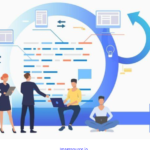The administration and support of IT services, or IT service management (ITSM), is essential for providing excellent customer service. It includes service-level management, issue management, incident management, change management, and releases management. Maintaining it streamlined and optimized is crucial since it’s essential to providing excellent customer service.
What Is Automation In ITSM?
The technologies and procedures known as ITSM (IT Service Management) are used by businesses to enhance how IT services are provided to end users. Automation in ITSM refers to the automation of certain procedures to increase overall effectiveness and decrease manual labor for service desk staff. Creating and recording issues and delivering automatic responses to straightforward queries through a self-service portal are possible operations that may be readily automated.
Here are some ways in which automation may support such initiatives:
- Improve Customer Experiences
The firm may benefit and spend less money if the IT services and IT operations teams can collaborate. A single cloud platform provides all that, plus up to 30% more productivity.
- Quickly Accomplish More
Automating repetitive operations may free up staff members’ time so we can concentrate on the job that matters most. Machine learning advances such automation even further, providing even more advantages.
Work is made simpler by ServiceNow IT service management services Predictive Intelligence’s automated use of machine learning to:
- Sort tasks, occurrences, and cases
- Suggest actions and materials aid with quick problem-solving
- Decide on and prioritize significant situations.
- Enhance Self-Service
An AI-powered chatbot may address common consumer queries, deliver content, gather user information, and help. ServiceNow Virtual Agent uses natural language understanding (NLU) to conduct client interactions and support self-service tasks like password reset and system status updates.
We can register for various programs available online to “Jump-start” our digital transformation. Various webinars available online might help us to find out how virtual agents could provide us with a speedy return on our investment The ServiceNow consulting services explain how an AI-powered chatbot might speed up the digital transition.
- Less Repetitious Work
By automating ITSM, we may also lessen the routine, easy daily activities our service desk staff must do. Password resets are a simple job that can be automated, freeing up IT specialists to work on more complex problems. This can reduce end-user downtime and more than 40% of service desk calls.
- More Efficient Incident Handling
When a client submits a request, it must reach the individual with the requisite expertise to assist the consumer in solving their issue. By detecting the characteristics of incidents and service requests within a certain category based on data from the knowledge base, AI facilitates allocating incidents to the appropriate individual. Additionally, it may provide ideas to service desk staff for additional fields to make incident and service request forms.
- Easy Access to Customer Feedback
Leaders may close the gap between the tasks their organization should and can perform by effectively gathering user input from those who request tickets and those who fulfill them. Without the need for a protracted team or company-wide conversation, automation may make it easier to collect ideas, comments, and proposed changes to procedures. After each interaction, a quick poll may let management know which areas want further simplification. Automation may also reveal whether parts are excessively complex and need further inspection.
Types of Automation
Automation may be used by businesses to manage almost any job. More complicated automation may need specialized software or even artificial learning programs. Basic automation often entails delegating specific activities to automated systems and mainly depends on automation technologies. Here are some instances of business automation.
- Organizational Process Management
In the administration of corporate processes, automation is crucial (BMP). BMP refers to an organization’s techniques to assess, evaluate, and enhance business operations for better productivity and lower costs.
- Automating DevOps
Automation may be used by development and operations teams to enhance workflows, security testing, infrastructure installs and modifications, and configuration management change validation.
- Process Automation
When automation is used to assist a workflow, efficiency and visibility are enhanced. Employee dependence, a lack of transparency, as well as unnecessary bottlenecks and delays are all problems that process automation addresses.
- Orchestration
By automating computer networks, applications, and services, orchestration increases workflow effectiveness. Automation of IT-related processes via orchestration reduces the strain on the IT staff.
Orchestration Vs. Automation
While most businesses may not understand orchestration, automation is understood by many. Automation is a part of orchestration, but it goes further. Numerous jobs may be automated together with orchestration, enabling fully automated processes to run smoothly and successfully.
The Conclusion
How we handle business chores is about to alter, thanks to the developing technology of automation. Automation is primarily designed to provide more time and flexibility to concentrate on strategy, innovation, and the customer experience, even if it comprises a variety of solutions that offer several useful services. ServiceNow delivers the tools, solutions, and platform we need to help make the goal of powerful automation a reality.








